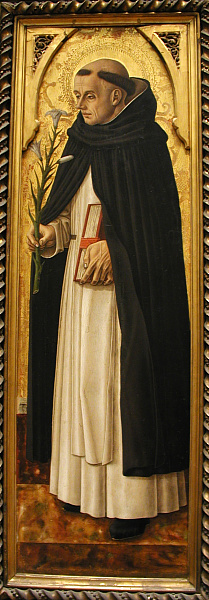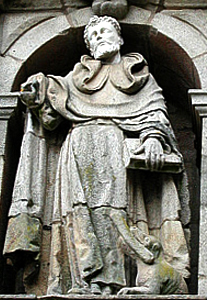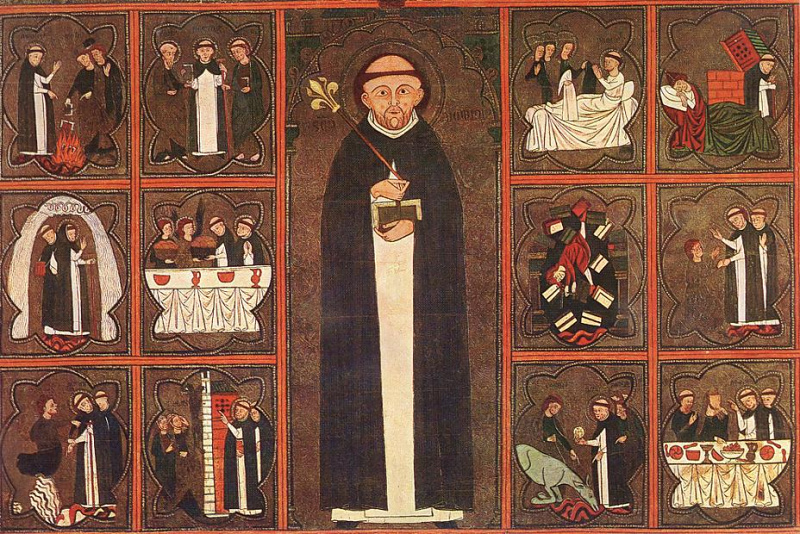Because of the wide reach of the order, images of St. Dominic are very common in Latin countries. Sometimes if it is clear who the figure is the saint's only attributes will be his book, tonsure, and Dominican habit. Otherwise he will be identified by one or more of these attributes:
LILIES
Perhaps the most common attribute is a stalk of lilies, as at right. The lilies refer to the saint's notable chastity. (For example, see this passage in the Golden Legend.)
A DOG WITH A TORCH
In the Golden Legend St. Dominic's mother while pregnant dreams that she will give birth to a dog who will hold a torch in its mouth and "burn the world." It has been suggested that the dog represents a pun on Dominicanus, the word for a Dominican friar, and Domini canis, "dog of the Lord." At any rate, a dog is often shown at the saint's feet holding a torch in its mouth, as in the second picture at right.
A STAR ABOVE THE FOREHEAD
The Legend also relates that at St. Dominic's baptism his godmother saw a star on his forehead, so another common attribute is a star usually just above the forehead (example)
THE ROSARY
Centuries after Dominic's death a tradition developed that it was he who introduced the Rosary A loop of beads for counting off a number of "Hail Mary" prayers interspersed with the Lord's Prayer and the "Glory be." to the world, having received it in a vision from the Virgin Mary and the Christ Child (example). In many images Mary and the Child dispense two rosaries, one to Dominic and one to St. Catherine of Siena (example). Tiepolo has a grand ceiling fresco in which Dominic passes on the rosary to the multitudes. At the base of the image he places the souls in Purgatory, for whom the faithful are especially encouraged to pray the rosary. Many other images of the institution of the rosary also emphasize the importance of this prayer for the souls in Purgatory (example).
By the beginning of the 20th century Catholic historians had rejected this tradition as completely unfounded. There is no mention of the rosary or any rosary vision in any of the documents from St. Dominic's lifetime, nor in the early biographies, nor in the dossier compiled for his canonization (Catholic Encyclopedia, s.v. "Rosary"). Even so, the tradition lives on. After World War II, among the new stained glass windows created for Munich's cathedral was one of Mary handing Dominic a rosary constructed in the modern style familiar to 20th-century Catholics.
OTHER IMAGERY
Although Dominic's innovation was to found an order dedicated to preaching in the world, the legends still attribute to him the virtues of a contemplative. Thus Fra Angelico painted several frescos for the convent of San Marco in Florence of the saint kneeling before and/or embracing the Cross in the manner of St. Mary Magdalene (example), and Tarchiani's Saint Dominic in Penitence illustrates the Golden Legend's passage on his nightly penitence.
The Legend says that after receiving Dominic's request to establish the Order of Preachers the Pope had a dream in which the saint was protecting the church of St. John Lateran from falling down, and that the pope thereupon decided to honor Dominic's request. The dream is pictured in a 15th-century manuscript illumination in the Metropolitan Museum.
MIRACLES
Unsurprisingly, a great many miracles are attributed to St. Dominic. In one repeated in a number of his vitae, he and a group of Cathars test the validity of their respective beliefs by building a great fire and tossing into it Dominic's book of his teachings and the Cathars' book of theirs. The Cathar book burns up, but Dominic's jumps out of the fire unharmed (image).2
Prepared in March, 2015 by Richard Stracke, Emeritus Professor of English, Augusta University, revised 2015-10-25, 2017-01-16, 2017-10-30, 2020-04-29.
HOME PAGE

Crivelli, St. Dominic, circa 1472 (See the description page)

Statue of St. Dominic outside a church in Compostela, Spain (Photograph by Richard Stracke, shared under Attribution-NonCommercial-ShareAlike license.)

Catalonian altarpiece with episodes from St. Dominic's life (See the description page)
MORE IMAGES
- 15th century: A della Robbia Lunette with the Madonna and other Dominican saints.
- 1473: St. Dominic is included in a Vivarini triptych.
- 1485-90: Ghirlandaio's fresco of the miracle of the books.
- 16th century: A fresco in Murano, Italy.
- 17th century: Filippo Tarchiani, Saint Dominic in Penitence.
- Undated, probably baroque: A relief of Dominic worshipping the Trinity that may reflect his preaching against Albigensianism.
- Undated: A sculpture in St. Peter Martyr, Murano, pictures the Madonna and Child giving the rosary to Dominic and Catherine of Siena.
DATES
- Lived 1170-1221
- In 1970 the Roman Catholic Church changed St. Dominic's feast day from August 4 to August 8.
BIOGRAPHY
- Golden Legend #113: html or pdf
- Early South English Legendary, 277-88
- Internet Medieval Sourcebook, under "High Middle Ages"
- Dominic's vita in The Roman Breviary: English translation, III, 787-88; Latin original, 958-59
- Acta Sanctorum, August vol. 1, 358-658
ALSO SEE
NOTES
1 Farmer, 123-24. Catholic Encyclopedia, s.v. "Order of Preachers."
2 The story is told in three vitae published in the Acta Sanctorum, August vol. 1: 547-48 (B. Jordanus, chpt. 1, ¶20), 560 (F. Bartolomaeus, ¶ 54), and 569 (F. Theodoricus de Appoldia, chpt. 2, ¶ 31). The Golden Legend has a somewhat different account, in which St. Dominic gives a Cathar a paper (schedula) summarizing his arguments and later, sitting around a fire with other Cathars, the man tosses the paper into the flames and it jumps out unharmed. The Legend reduces the other version to the simple sentence, "it is said that a similar thing happened about that time at Fanjeaux, where a formal debate with the heretics was held" (Ryan, II, 45).